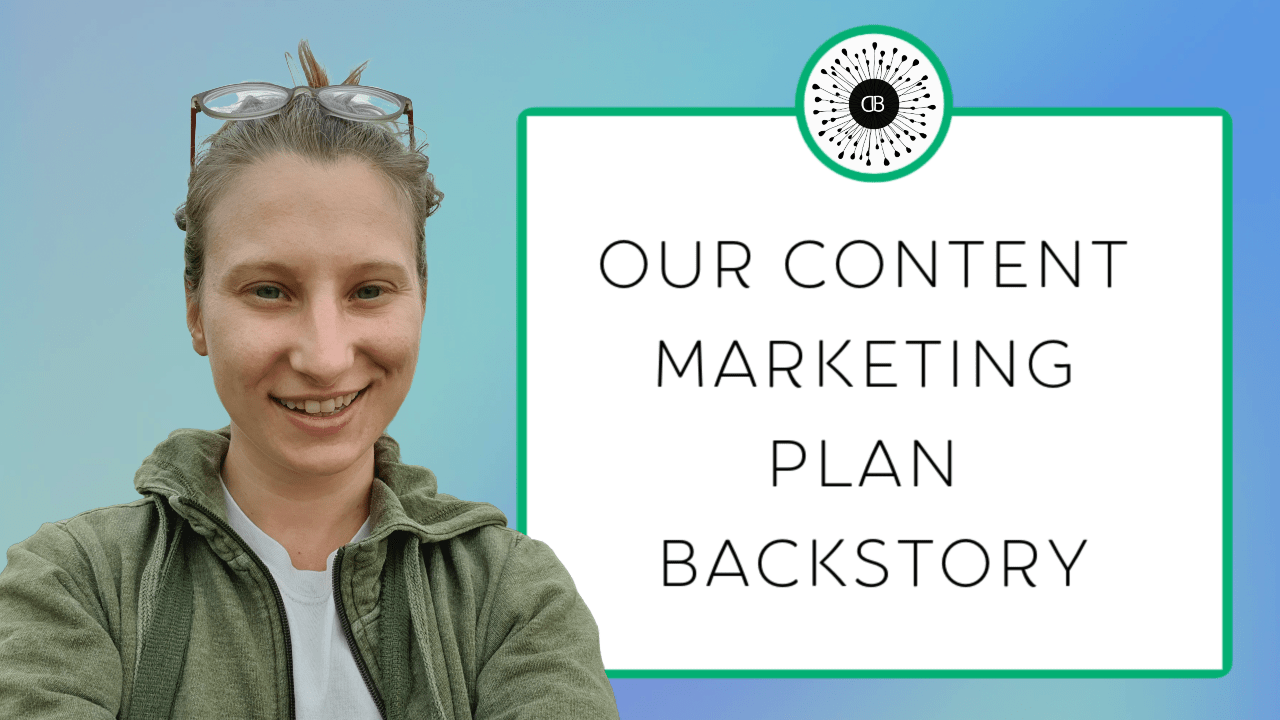This article is a bit different than my other ones because it’s almost entirely anecdotal. This is the true story of how our content marketing plan method came to be.
Courtney made a really wonderful video about our course session that tells you about what a content marketing plan actually is. She shared a little more about what you’ll learn in our course too definitely check it out and subscribe.
TL;DR. The method took years, subjective research, creative problem solving, improving communications, and easing growing pains.
The Content Marketing Plan Backstory
Courtney and I met in 2014 we worked together for a brand in Berkeley, California.
When I started working there, I had just stepped away from the first media company I had founded. I was looking to take a step back from working 70-80 hours a week to focus on studying to become a certified herbalist. To do that, I took a job in a customer support role at an herbal brand.
That “step back” didn’t work out as planned – I’m a workaholic. So within a few months, I was writing several articles a week for the blog, setting up a better way to have guest bloggers, and helping to upgrade the organization of the media portion of the brand.
As the team grew, we were finding massive holes and duplication around the editorial portion of the brand. That’s frustrating for any team, so I openly took it upon myself to create a method that worked for everyone.
How Our Content Marketing Plan Method Came to Be
What I knew: there has to be open channels communication between the editorial coordinator (me), the designer, social media person, copywriter, marketing manager, operations and design teams (via Courtney), and the affiliate team to make sure that we all stayed on the same page with the brand messaging. Now… how to do that?
I’m a systematic thinker and a creative problem solver (luckily, in that order). I always start by trying to get an understanding of the actual issues at hand to come up with the right solution.
The research phase
Do you know what happens when you ask 10 people sitting in the same room a question about planning their work? What about asking a group of people to change the way they structure their working day? Chaos. Stress. Disagreements. Questions.
AAANND… That’s how I learned that utilizing groupthink is NOT a productive way to create a new content marketing method.
So I scheduled an individual meeting with every person whose position touched marketing planning. I talked to each member of the team about the struggles they were having with the current system. Then I took notes on what types of information each department actually needs.
With my research in hand, I diagnosed the main issue as the need for “company-wide transparency,” and I created a preliminary structure in a series of spreadsheets. This would let us display what needed to be done so that everyone could FIND what they needed.
Yeah, that didn’t work.
What went wrong
It was certainly a step in the right direction – but this one positive system change brought all the other issues that we were experiencing to light! I basically went back to the research phase and asked everyone again what they were experiencing.
Here’s what I found out in my 2nd research phase:
The designer was still being asked for 100 different designs and even though we had nicely laid out spreadsheets, we still had long chains of emails for transporting imagery. (And crossed fingers that everyone hit “reply all.”)
There was also very little coherence between the pillar content to emails strategy and the social media content. Since the schedules were submitted for approval at the same time, it was hard for the social media person to align posts with the emails.
The affiliate team was running on the assumption that we could plug in cross promotions anywhere (we couldn’t).
And the operations team was grateful for the visibility but found it cumbersome to search several spreadsheets to find everything.
I also started talking to Courtney A LOT about the programs she was using. She was coordinating projects between the operations, marketing (via me), customer support, and design teams so I knew she was solving similar issues.
In other words: .GROWING. PAINS.
The Solution: A Holistic Content Marketing Plan
What we realized with our multi-spreadsheet organization mess was that we needed a way to centralize everything related to our content marketing plan – and what did that mean?
We needed:
- Everyone to see every outward-facing initiative (not just their own) in one place.
- To have enough information in that one location so that everyone with action items know what they need without digging.
- A place where social media, pillar content, and email could have a cohesive brand focus.
- A clear idea of where cross promotions could fit into the plan without causing team-wide frustration.
- A way to share design and copy that didn’t involve massive email chains.
First, our marketing manager asked about putting all of the deliverables into one master marketing spreadsheet. YES! This was hugely helpful. We were able to plan pillar content, social posts, and email together now. The affiliate team could also see where it made sense to add a cross promotion, and everyone could see the upcoming initiative.
But this only solved about half of the problems.
It turned out that now everyone could see WHAT was happening, but HOW it was going down was still buried in the same damn email threads. (Can you tell that I hate searching through long email threads?)
This is when the conversations with Courtney around the organizational programs she was using started to make sense for my team too. I decided to go with Trello because it’s very simple (and free) to use.
I made each line on the master marketing spreadsheet a task on the Trello board. Then I filled in subtasks to complete for each task. I invited everyone to the board and explained my idea for how it would work. Once everyone was trained on how to use the board, our deliverable time was easily cut in half.
The designer and the copywriter could share their work right in the task! No more email chains! Conversations about initiatives became immediately clear because they could all happen on the Trello board! Everyone could stay updated on what was happening in real time!
Suddenly we had a simple, clear solution to a problem that had been broiling for several years.
And thus – the holistic content marketing plan was born.
The Holistic Content Marketing Plan: Tried, Tested, and Evolved. (FAQs)
What size team can operate with this structure?
Since 2017 when this structure was created, we’ve set it up for half a dozen teams and taught several more brands the basis of running their marketing operations holistically.
I have run it on projects that I have operated alone and it works, but since there’s no one to share information with, it feels a little extra.
BUT – once the team is at 2 (like us) all the way up to teams of 15 this structure is the bomb dot com. We would love to set it up for a team of 20 or even 50 though. We have a theory that this marketing structure WORKS. Brands find it totally scalable and easy to train new members on – cause it just makes sense.
What is the downside of the holistic content marketing approach?
It does take some time each month to set this system up. This isn’t really a “downside” because it saves so much time in the long run, but it’s something to get used to.
We have only ever seen one actual downside. Because this system is fully integrated into a brand, if a member of the team doesn’t want to operate within this type of structure, it becomes very difficult to maintain.
You literally just have to be on board with efficiency and this structure WILL work for you.
How has your structure changed since its inception?
To be honest, the basic principle behind the holistic content marketing plan is the same!
We still use a spreadsheet for a basic plan overview, but it’s gotten fancier. It’s automatically color coded now by the type of content. It’s also simplified to just have the due date, the platform, and the basic content title.
The task platform we suggest using now has also changed. Instead of Trello, we operate in Asana. Courtney fully turned me into an Asana lover in our first year of Dandelion. It was so hard for me to migrate, but Asana is a great project management tool for brands that want to manage multiple boards (we do).
The biggest change is that we also set up Asana as a built-in deadline creator for the calendar. And each of the tasks has its own shorthand so we know exactly what we need just by glancing at the board.
How You Can Learn This Structure
Creating a holistic content marketing plan doesn’t have to be a crazy 2 year trial and error project for you. We can literally just show you how to do it every step of the way.
If you’re already creating content consistently and you just want our asana board template, send an email to info@dandelionbranding.com and we’ll give that to ya.
But if you’re struggling with producing, scheduling, and marketing the content for your brand, take the course.
Click Here to Learn More about Session Three of the Bloom Your Brand Course.
And I’ll tell you this: I took a content marketing course when I first got started too! It was a great foot in the door, I loved it, but it was more expensive and less detailed (and also way less fun) than ours is!
Do you have a content marketing plan? Tell us how you developed it in the comments!


